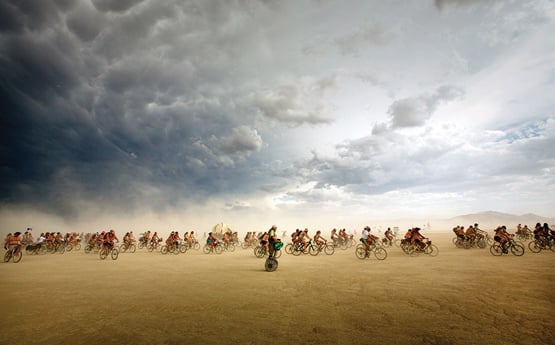Love and the Apocalypse: Culture Shift
- How to See Stars Like Your Ancestors Did
- Share

A starry night sky in Joshua Tree National Park, Calif. Photo by Ross Manges.
How to See Stars Like Your Ancestors Did
We could all see the sky as our ancestors once saw it just by turning off the lights, according to the International Dark Sky Association.
1. Catch a meteor shower
Meteor showers occur when the Earth moves through debris left by passing comets. They’re named according to the constellation from which the meteors appear to fall. In general it’s best to view meteor showers after midnight, looking east.
Look for the most brilliant meteor showers in the latter half of the year. The Perseids will fall between Aug. 13 and 14, the Leonids follow on Nov. 17 and 18, and the brightest of all, the Geminids, finish the year on Dec. 13 and 14.
2. Share the view
Want some help finding the stars? Your nearest college or university may have an observatory with public viewing hours. Visit during the day to use high-quality telescopes to view sunspots and solar flares, and during night sky observation hours to stargaze like an astronomer.
Ever attend a star party? Some stargazing events last for days. Search online for your local stargazing meetup or astronomy club, or arrange a star party of your own.
The best stargazing spots are away from city lights, but you don’t need to go into the wilderness. Members of the Amateur Astrono- mers Association of New York use binoculars and telescopes to observe the heavens from America’s most populous city.
The National Star Party, held over several nights in September, will feature astronomers showing stars and planets to the general public. You’re welcome to share the view.
3. Find your pole star
How starry is your sky? Try looking on a clear night, away from outdoor lighting, when the moon is new or in its last quarter. Give your eyes 20 minutes to adjust to the darkness.
Polaris, also called the Pole Star or North Star, is visible from Earth’s Northern Hemisphere and remains at its northern position while the other stars rise and set. Find it by locating the Big Dipper and “drawing” a line from the edge of the dipper’s bowl to the first brighter star.
NASA has an online planner showing what you can find in the night sky and giving predicted viewing conditions for your area. You can download free monthly sky charts at skymaps.com, which offers simplified maps and calendars listing objects you can see near the moon each night of the month. Also check out daily info at earthsky.org/tonight.
4. Protect dark skies
The International Dark Sky Association sees dark nights as an inspiring natural resource that needs protection. Light pollution is growing four times as fast as population, and there is approxi- mately one streetlight for every 10 people in the United States. Excessive night lighting obscures our view of the stars and disrupts our circadian rhythms. It’s harmful to human health and to animals whose instinctive behaviors are disrupted by artificial light.
It also wastes energy. France recently passed a light pollution law requiring nonresidential buildings to go dark by 1 a.m. The new law is expected to cut CO2 emissions by 250,000 metric tons a year. Lighting ordinances already exist in some parts of the United States, and they can be very effective. A strong ordinance in Tucson, Ariz., means light pollution there hasn’t increased in 20 years, and you can enjoy a view of the Milky Way from just outside the city limits.
5. Turn down the lights
For outdoor home lighting that reduces light pollution: Keep it dim. At night, lights don’t have to be bright to be effective. Bright lights illuminate the immediate area but can prevent your eyes from adjusting enough to see objects farther away. Keep it low. Small, dim lamps along paths are all you need to walk safely, and they won’t cast light uselessly into the sky. Make sure outdoor lights are shaded and pointed downward. Lights are most useful when people are around to see what they illuminate. Motion-sensor outdoor lighting saves electricity and minimizes skyward glare. It also helps deter crime by indicating the presence of intruders.

|
Katrina Rabeler
is an environmental specialist at Ecology and Environment, Inc. and a former editorial assistant for YES!
|

